5.1: Introduction to Business Communications
5.1.1: The Importance of Clarity in Professional Settings
Communication is essential for effective business operation, and clarity leads to effective communication.
Learning Objective
Define business communications and the importance of clarity in business communications
Key Points
- Business communication is used to promote a product, service, or organization; to relay information within the business; or to deal with legal and similar issues.
- Failures of human communication can become amplified in professional settings. In business transactions, especially those involving large amounts of money, a small miscommunication can have devastating effects.
- Customer relationship management (CRM) is a widely implemented model for managing a company’s interactions with customers, clients, and sales prospects. It is needed because there are often multiple business associates that come into contact with a client.
- Barriers to clarity in communication include: complex messages, the withholding of information, ineffective communication throughout the chain of command, and lack of trust due to competition.
Key Terms
- miscommunication
-
an interaction between two parties in which information is not communicated as desired
- communication
-
an instance of information transfer; a conversation or discourse
Example
- CRM – Salesforce.com provides end-to-end customer sourcing and customer relationship management.
Business Communication Defined
Business communication is used to promote a product, service, or organization; relay information within a business; or deal with legal and similar issues. It encompasses a variety of topics including: consumer behavior, advertising, public relations, corporate communication, research and measurement, reputation management, and event management. Business communication may also refer to internal communication: a communications director will typically manage internal communication and craft messages sent to employees. It is vital that internal communications are managed properly because a poorly crafted message could foster distrust or hostility among employees.
Failures of human communication can become amplified in professional settings. In business transactions, especially those involving large amounts of money, a small miscommunication can have devastating effects. For this reason, clarity is absolutely essential. Communication must be consistent, concise, and honest in order to ensure the intended message is received.
Barriers to Clarity in Business Communication
- Complex messages: The use of complex technical terms can result in a lack of clarity. The solution is to stick to the point by using clear and concise messages that are easy to understand.
- Withholding information: Within an organization, some information is kept confidential due to company policies. Make sure the information that is needed is readily available and easily accessible.
- Chain of command: The maintenance of an organization’s hierarchy is essential, but its very presence can reduce the flow of the communication. It is therefore essential to reduce hierarchical levels and increase departmental interaction and communication.
- Lack of trust: The most important cause of a lack of communication within an organization is competition, which leads to a lack of trust among employees. Therefore, employees should share information, communicate openly and honestly, and involve others in decisions.
Customer Relationship Management
Customer relationship management (CRM) is a widely implemented model for managing a company’s interactions with customers, clients, and sales prospects . It is needed because there are often multiple business associates that come into contact with a client. CRM involves using technology to organize, automate, and synchronize business processes—principally sales activities, but also those for marketing, customer service, and technical support. CRM helps everyone in a business stay on the same page and promotes clarity of communication with those outside the organization.
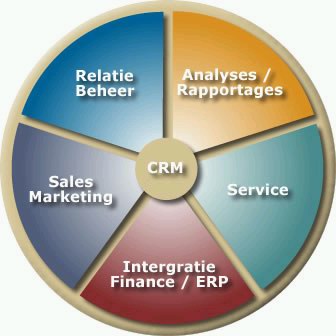
Customer relationship management (CRM)
Customer relationship management (CRM) is a widely implemented model for managing a company’s interactions with customers, clients, and sales prospects.
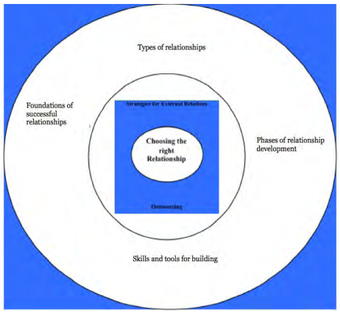
Developing Relationships
Developing relationships is essential for the effective operation of a business, and clarity of communication is essential in developing relationships.
5.1.2: Creating Effective Messages
The goal of public relations is to disseminate information about a business (that is, to create an effective message).
Learning Objective
Explain how to create effective messaging via public relations
Key Points
- All communication with the media should be clear, concise, and contain all of the pertinent information about the event or product, such as date, time and location.
- Remember to keep the communications free of typos and grammatical errors.
- One way to get attention is to describe a problem, and then explain how the business or product solves that problem.
- One goal of a public relations campaign is to generate editorial coverage for a business, because editorial coverage is perceived as more authentic than advertising.
Key Terms
- disseminate
-
To sow and scatter principles, ideas, opinions, and errors for growth and propagation, such as seed
- buzz
-
Major topic of conversation; widespread rumor; information spread behind the scenes.
Creating Effective Messages
The goal of public relations is to disseminate information about a business. This information can be in advance of upcoming events or product launches, or to quell rumors or stop the spread of incorrect information about a company. Public relations also involves proactively educating staff on responding to media so incorrect information is not released in the first place.
Many small businesses and start-ups lack large advertising budgets; they rely on public relations to build a “buzz” about an upcoming business or product launch. One goal of a public relations campaign is to generate editorial coverage for a business, because editorial coverage is perceived as more authentic than advertising.

Effective Messages
A press release contains all the pertinent information about an event, product, or company.
The problem is getting attention from the media is not easy. The solution is to craft well-written, attention-getting press releases and submit them to the right media outlets. For example, a fashion press release should go to fashion-related media, not a sports journal.
Media Communication
All communication with the media should be clear, concise, and contain all of the pertinent information about the event (or product) such as date, time, and location. This information is often the most critical, so it should be at the top of the press release.
Many press releases also include some background information about the company and sometimes the team members for a particular project. This information is generally found at the bottom of the press release.
Remember to keep the communications free of typos and grammatical errors. For maximum effect, try to incorporate attention-grabbing language. One way to get attention is to describe a problem, and explain how the business or product solves that problem.
5.2: Means of Communication
5.2.1: Choosing the Right Method for the Message
Channels for business communication include meetings, letters, print, radio, television, telephone, word of mouth, and the Internet.
Learning Objective
Define the various communication channels available for packaging and delivering business messaging.
Key Points
- Each communication channel has a variety of specific methods. The Internet, for example, could entail a web-based advertising campaign, a social media advertising campaign, or a website.
- It is important to choose the right method for the message. A company-wide email detailing the holiday hours is acceptable, but a company-wide email listing terminations is not acceptable.
- Consider the audience and their reaction to the message. If a message may invite a lot of questions, a face-to-face meeting will be more beneficial than an email. For example, a message about employee benefits could cause employees to have questions, so this type of message is best presented in a group meeting that allows for a question-and-answer session.
Key Terms
- communication
-
an instance of information transfer; a conversation or discourse
- word of mouth
-
Verbal means of passing of information.
Examples
- Meeting – A personal, interactive exchange often succeeded by a written follow-up; Letter – Typically a formal method of communication suited for important messages such as proposals, inquiries, agreements, and recommendations; Video Conference – Allows people in different locations to hold interactive meetings and interviews in real time; Telephone Conference – Enables participants in different locations to share information; E-mail – Instantaneous medium for both formal notices and updates, as well as, informal exchanges; Report – Official documentation of the activities of any department or organization; Presentation – Usually comprises a formal proposal, update, recommendation, or report involving audiovisual material, slideshows, and statistics; Web-based Communication – A method typically suited for leaving contact information (such as address and phone number) or for sharing transaction details (such as order confirmation); Forum: Allows members to post information publicly and efficiently in a centralized location.
- E-mail (Electronic Mail) is a fast, reliable way of sending messages and interacting with people. This medium straddles the line between informal communication and formal business interaction. All e-mails are saved and recorded, as well as, potentially read by any number of people.
- A memo or memorandum is a communication note that records events or observations on a topic. Memos are typically used as an internal communication tool. They call attention to issues that may need to be resolved.
- Business letters are written messages to a person or group within a professional setting. It can address anyone including, but not limited to, prospects, clients and customers, managers, agencies, suppliers, and other business personnel or organizations. It is important to remember that any business letter is a legal document between the interested parties.
Choosing the Right Method for the Message
Business communication encompasses various channels of communication, including meetings, letters, memos, print (publications), radio, television, telephone, word of mouth, and the Internet.
Specific Methods
Within those channels is a variety of specific methods. The Internet, for example, could entail a web-based advertising campaign, a social media advertising campaign, or a website.
Other methods of communication include:
- Meeting – This is a personal, interactive exchange often succeeded by a written follow-up.
- Letter – This is a formal method of communication typically suited for important messages such as proposals, inquiries, agreements, and recommendations.
- Video conference – These allow people in different locations to hold interactive meetings and interviews in real time.
- Telephone conference – These enable participants in different locations to share information.
- E-mail – This is a instantaneous medium for formal notices and updates, as well as informal exchanges.
- Report – This is the official documentation of the activities of any department or organization.
- Presentation – This method usually comprises a formal proposal, update, recommendation, or report involving audiovisual material, slideshows, and statistics.
- Web-based communication – This method is typically suited for leaving contact information (such as address and phone number) or for sharing transaction details (such as order confirmation).
- Forum This method allows members to post information publicly and efficiently in a centralized location.
With the variety of methods available, it is important to choose the right method for the message. A company-wide email detailing the holiday hours is acceptable, but a company-wide email listing terminations is not acceptable .

Choosing the right method for the message.
A company wide email detailing the holiday hours is acceptable, but a company wide email listing terminations is not acceptable.
When choosing the medium, consider the audience and their reaction to the message. For example, if the message is about employee benefits, the audience most likely will have questions, so this message is best presented in a group meeting that would allow for a question and answer session.
5.2.2: Minimizing Risk of Miscommunication
Miscommunication happens when there is a disconnect between what is being said and what is heard.
Learning Objective
List the six leading causes of miscommunication in businesses
Key Points
- There are six things that cause miscommunication: complex messages, withheld information, hierarchy, silos, lack of trust, and language barriers.
- In business, a miscommunication can lead to costly errors or deadly mistakes.
- When it comes to effective communication, there are certain barriers that every organization faces, such as message overload, which can occur when a person receives too many messages at the same time.
Key Terms
- hierarchy
-
Any group of objects ranked so that every one but the topmost is subordinate to a specified one above it.
- miscommunication
-
an interaction between two parties in which information is not communicated as desired
Examples
- Here are six reasons that cause miscommunication: Complex Messages: The use of complex technical terms can result in miscommunication. Use clear and concise messages that are easy to understand. Withholding Information: For many organizations, important information can be kept confidential due to company policies. Make sure that needed information is readily available and accessible. Hierarchy: Management must keep employees well-informed and encourage feedback. Silos: Hierarchy in an organization is essential but it can also reduce the flow of communication. It is therefore essential to increase departmental interaction and coordination. Lack of Trust: Competition between employees and managers leads to a lack of trust. Share information, communicate openly and honestly, and involve others in decisions. Language Barrier: Due to globalization, messages must be effective when conveyed to a diverse audience.
- Message complexity can also result in a confused audience.
- Message overload can result when a person receives too many messages at the same time.
Miscommunication Defined
Miscommunication happens when there is a disconnect between what is being said and what is heard. In business, a miscommunication can lead to costly errors or deadly mistakes.
Reasons for Miscommunication
Here are six things that cause miscommunication:
- Complex messages: The use of complex technical terms can result in miscommunication. Use clear and concise messages that are easy to understand.
- Withholding information: For many organizations, important information can be kept confidential due to company policies. Make sure that needed information is readily available and accessible.
- Hierarchy: Management must keep employees well-informed and encourage feedback.
- Silos: Hierarchy in an organization is essential but it can also reduce the flow of communication. It is therefore essential to increase departmental interaction and coordination.
- Lack of trust: Competition between employees and managers leads to a lack of trust. Share information, communicate openly and honestly, and involve others in decisions.
- Language barriers: Due to globalization, messages must be effective when conveyed to a culturally diverse audience.
Minimizing the Risk of Miscommunication
When it comes to effective communication, there are certain barriers that every organization faces, such as message overload, which can occur when a person receives too many messages at the same time.
Message complexity can also result in a confused audience. There are several ways to ensure your message is received and understood. When creating the message, read the draft several times and look for confusing statements or awkward wording. After doing that, edit the message for content to ensure there is a clear focus or main idea. Lastly, edit for grammar and misspelled words.

Miscommunication
Complex language often leads to miscommunication.
5.3: Creating High-Value Communications
5.3.1: Appropriate Tone
In writing, tone is defined as the author’s attitude or emotion toward the subject and the reader.
Learning Objective
State the factors that determine appropriate tone in business writing
Key Points
- In business writing, using the appropriate tone ensures that the message is communicated properly. Even the most positive message can be misunderstood if the tone is not correct.
- Answering these questions will help you determine the tone of your communication: What is the purpose of the communication? Who is the audience? What should the audience learn? What actions should the audience take from the communication?
- Most business correspondence is written in the formal tone.
- Accurate interpretation of messages is made easier when nonverbal and verbal communication complement each other.
Key Terms
- tone
-
The manner in which speech or writing is expressed.
- subordination
-
The quality of being properly obedient to a superior (as a superior officer).
Example
- Most business correspondence is written in the formal tone. The exception is internal email communications between coworkers. Even then prudence must be taken, as an email to a supervisor requires a more formal tone than one to a coworker requesting a lunch date.
Appropriate Tone
In writing, tone is defined as the author’s attitude or emotion toward the subject and the reader. While this might only seem appropriate for writers of literature, business writers also need to be concerned about tone. In business writing, using the appropriate tone ensures that the message is communicated properly. Even the most positive message can be misunderstood if the tone is not correct. Answering the following questions will help you determine the tone of your communication, whether it be a letter, memo, or proposal:
- What is the purpose of the communication?
- Who is the audience?
- What should the audience learn?
- What actions should the audience take from the communication?
Formal and Informal Tone
Most business correspondence is written in the formal tone . The exception is internal email communications between coworkers. Even then prudence must be taken, as an email to a supervisor requires a more formal tone than one to a coworker requesting a lunch date. A piece of correspondence written in the formal tone contains the proper subordination, is free from discriminatory language, and contains no slang or text speak. Remember, the overall tone for any business writing is confident, courteous, and sincere. It is important to avoid writing that is overly formal; don’t use long phrases such as “in the event that” when a simple “If” will do.

Appropriate Tone
Most business writing, with the exception of interoffice emails, is written with a formal tone.
Tone and Negative Messages
If the purpose of the correspondence is to deliver a negative message, it is especially important to consider tone. In a negative message, it is best to use a gracious and sincere tone. Try to avoid using the active voice when delivering negative messages.
5.3.2: Using Formatting for Visual Flow
In business writing, the formatting of a document should add to the reader’s ease of understanding.
Learning Objective
Summarize the benefits of formatting visuals in business communications
Key Points
- Common formatting guidelines for business writing include using clear headers, including charts and graphs, and using color to emphasize important information.
- Visuals are commonly used in business settings; they aid in running effective meetings and communicating complex information.
- When using presentation software to create visual presentations, keeping text minimal and visuals clear is particularly important.
- Use color for clarity and emphasis, not for decoration.
- Use bullet points or create lists to organize material. Make sure this is “nice” to look at (easy to read).
- Keep paragraphs short and to the point, ensuring that sentences contain complete thoughts.
Key Terms
- visual
-
All the visual elements of a multi-media presentation or entertainment, usually in contrast with normal text or audio.
- PowerPoint
-
An electronic slide presentation.
Example
- A slide showing revenue trends over the past three years could, for example, include a bar graph of revenue per year on the left of the slide with two to three bullet points to the right of the graph listing major factors influencing the revenue values.
In business writing, how the message is presented is just as important as the message itself. The goal is to produce a well-formatted document that presents all the information in a concise and easy to read manner. The formatting of a document should never make a document more confusing, but rather add to the reader’s ease of understanding.
General guidelines for formatting documents
Labeling
- Use headlines and sub-headlines in large font
- Bold, italicize, or CAPITALIZE important information
- Use bullet points or create lists to organize material; make sure this is “nice” to look at (easy to read)
Charts and Graphs
- Make sure there is clear information presented and that it supports your point; color coordinate charts/graphs if necessary.
- Use text to support/explain charts and graphs (be brief but cover the high points)
- Avoid charts and graphs that can be misleading to your readers
Wording and Lettering
- Limit number of fonts to one or two
- Think about the age of your audience when setting font size and type
Color
- Use color for clarity and emphasis, not for decoration
- Keep a similar color scheme throughout the entire document
- Consider using contrasting colors to highlight main points
Formatting visuals
Visual documents are commonly used in business settings. A study done by the Wharton School of Business showed that the use of visuals reduced meeting times by 28 percent. Another study found that audiences believe presenters who use visuals are more professional and credible than presenters who merely speak. And still other research indicates that meetings and presentations reinforced with visuals help participants reach decisions and consensus in less time. A presentation program such as Microsoft PowerPoint, Apple Keynote, OpenOffice.org Impress or Prezi, is often used to generate the presentation content. Modern internet based presentation software, such as the presentation application in Google Docs and SlideRocket also allow presentations to be developed collaboratively by geographically separate collaborators.
The following are formatting guidelines specific to using PowerPoint or similar presentation software:
- Do not write out the entire presentation on your PowerPoint; instead, create bullet points and headings no longer than three to five words that give the main points
- Include no more than five to seven lines per slide; better to split information onto two slides than it is to cram too much information onto one
- Be consistent with your “theme” (do not use a different theme for each slide)
- Do not overuse flashy transitions; they are meant to enhance your presentation, not take over
- Be careful with your color scheme; again, this is meant to enhance your presentation
- Make sure that the text is big enough for the audience to read
- Do not use complicated or unreadable font
- Use a font color that stands out against the background
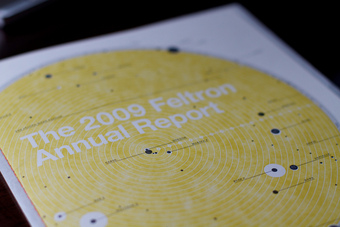
Visual Flow
Clear formatting can help make a business document easy to read
5.4: Effective Rhetoric and Presentation
5.4.1: Telling a Story
Storytelling is a powerful tool for leaders, entrepreneurs, and community managers to relay a vision and craft a strong sense of purpose.
Learning Objective
Learn the art of storytelling and recognize it’s applicability to various facets of the business world
Key Points
- It may come as a surprise, but many leaders in business argue that storytelling is one of the most powerful tools in the 21st century business environment.
- Leaders and entrepreneurs are tasked with creating organizational buy in, procuring funding and aligning resources on a single, centralized vision. This is not possible without a strong sense of story.
- Technology and social networks have turned marketing into the art of storytelling, in which engaging and building a community relies heavily on spinning intriguing tales.
- The art of storytelling requires engaging the audience, setting a scene, building tension, staying organized and focused, and ending with a powerful and meaningful conclusion.
Why Storytelling Matters More Than You Think
Leaders
Storytelling is an incredibly powerful skill set, both in regards to effective rhetoric and presentation and leadership. The ability to craft ideas such as strategy, tactics, consumer needs, core competencies, and other concepts into a speech, presentation, or group discussion can create a strong sense of vision, purpose, and unity. It is argued by some leaders in managerial thought that the ability to tell a story is the most important skill a leader can have in the 21st century.
Community Management
Aside from the leaderships and presentation frame, telling a story is the core skill set that enables a powerful presence on social media and other digital distributions of the company culture, brand, and value proposition. Storytelling is a way to relate to prospective users and build a powerful community, which is an invaluable asset in the success of any and all business ventures.
Entrepreneurs
It is also worth noting that start-up ventures require a strong sense of story. When pursuing investment, the entrepreneur must take the concept they are selling and spin it into a vision worthy of taking a risk on. Look no further than Kickstarter campaigns to see how critical it is to build a narrative, and find people who share your passion. This is the key source of enthusiasm and capital that enables start up companies to move forward.
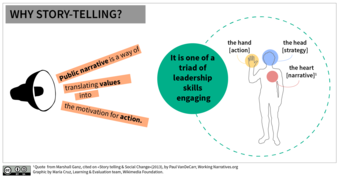
Why Story-Telling?
How To Tell A Story
Depending on the situation, there may be a wide variety of relevant approaches. Delivering a specialized presentation on how to integrate a software solution will undoubtedly require a different tactic than building a twitter community for a new soda brand. That being said, there are a few aspects to any good story that can help us effectively tell a tale:
- Engage the audience – To pull them into your story, you must involve them. Ask a challenging question, or raise a trending topic. Find something in their world, and use that as your starting point. Relevance is key.
- Set the scene – All stories need context, and context will act as a key counterpoint to what unfolds. Pull them into the world the story takes place in and you’ll have their full attention.
- It’s all about tension – Conflict, debate, struggle, emotions, find what it is about the story that creates a sense of tension and provide emphasis. This feeling of conflict has been central to storytelling for all of human history!
- Stay focused on the goal – Stories are anecdotes to communicate concepts. Stay focused on what it is within the story that is important, and relevant to the discussion you are trying to have. Keep the story grounded through the occasional reminder of what it is you’re really trying to say.
- Stay logical – Stories are like puzzles, the pieces need to fit. Keep things organized and maintain a sense of structure. Losing the thread will result in a story evaporating before your eyes.
- End with a punch – The conclusion is your chance to make a point with emphasis (!). Make sure the flow of your story results in a powerful and punchy conclusion that truly speaks to the audience.
5.4.2: The Beginning
Beginning a speech with a quote, statistic, story, or humor can make the audience feel interested and invested in what you have to share.
Learning Objective
Discuss the best practices for opening a speech using quotes, statistics, personal stories, humor, and overviews
Key Points
- It is important to remember to keep your introduction relatively short; wordy introductions can lose your audience before you actually get to the speech itself. It is also important to remember that whatever opening line you choose, you must connect it to the content of your speech.
- Beginning with a quote, statistic, personal story, or even opening with humor are all good options, but only if they are used correctly.
- If the presentation is more formal, you may just want to give an overview of the main topics you will cover in your speech. Using an overview as an opening would be a good choice if you are unsure how your audience will react to a joke or a startling statistic.
Key Term
- introduction
-
An initial section of a book or article, which introduces the subject material.
Example
- Martin Luther King gave one of the most historic and powerful speeches in history (“I have a dream”). It was a serious speech to a crowd of thousands, and he started with a call for justice and equality.
Ways of Beginning a Speech
When you begin your presentation, you want the audience to feel interested and invested in what you have to share. The more interested you get them right off the bat, the more they are going to pay attention throughout the rest of the presentation. This can be done in a multitude of ways, but it is important to remember to keep your introduction relatively short; wordy introductions can lose your audience before you actually get to the speech itself. It is also important to remember that whatever opening line you choose, you must connect it to the content of your speech.
The Opening
There are many ways to start a speech before segueing into an introduction: beginning with a quote, statistic, personal story, or even opening with humor are all good options, but only if used correctly. So be careful, because humor is only funny when it is told right, and humor can sometimes do more harm than good. Be sure to avoid all sexual, religious, and racial topics if you open with humor. It doesn’t matter if you open with a statistic, quote, or sharing a personal story; just be aware that what you choose must be directly related to the main point of the speech.
So how will you begin your speech or presentation? Will you start with a quote, statistic, personal story, a joke, or an overview?
Opening with a quotation
The use of quotations is a tried-and-true way of introducing a subject…if done correctly. Here is an example of an opening making use of a quote from Albert Einstein: “After the nuclear bombs were dropped during World War II, the leading creator of this destructive force said, ‘I know not with what weapons World War III will be fought, but World War IV will be fought with sticks and stones. ‘ Albert Einstein stated this after finally seeing the bombs’ full power; for he knew that he very well may have had a hand in the end of the world. “
Opening with a statistic
Startling statistics might draw the attention of your audience. The following examples concerns modern incarceration rates: “By the end of 2004, 724 out of every 100,000 U.S. residents were incarcerated. The United States of America has the highest jailing rate in the entire world. “
Opening with a personal anecdote
Sharing a personal experience is an effective, but risky, way of opening a presentation. Use this option only if it’s the right fit for your audience.
If you are presenting to a group of Video Game Design students at your school on the topic of fun game play elements, you might use a personal experience like this: “A few years ago, everybody was talking about how awesome this new game was and how sweet the graphics were. So, I did what any gamer would do–drove directly to the store, picked up a copy, brought it home, and popped it into my Xbox. My excitement heightened as the game loaded and the intro sequence played. When the game started, I was absolutely astonished…at how bad the game play was. The game looked cool, but all you did was run around and hit the enemies in the head with a sword over and over again. That game was not fun; let’s make a game that’s fun. “
Opening with humor
Using a joke to start a presentation is often a good idea, as long as it is appropriate. Also, try to make the joke pertain to the subject you are presenting. Here is an example that you might use when doing a presentation on football: “Anyone who makes a bad call against the Detroit Lions risks ticking off their last remaining fan.”
Opening with an overview
If the presentation is more formal, you may want to give a simple, structured overview of the main topics you will cover in your speech. Using an overview as an opening would be a good choice if you are unsure how your audience will react to a joke or a startling statistic.
Your overview should contain a brief introduction of your topic; an explanation of the relevance of the topic to your audience; a forecast of the organization for your presentation; and possibly some background information, if necessary.
Here is an example: “Today, I will be discussing college dropouts. I will be going over the current rate of dropouts, as well as the many common factors that affect these rates. I will also talk about the reasons to stay in college, including that college is a place where you can gain better knowledge, memorable life experiences, and the skills to earn greater pay in the future. “
If you’ve chosen to open with one of the other opening techniques, then an overview should always follow. While there may be rare individual speeches that do not benefit from an overview, there is no form of speech that isn’t improved by this method of welcoming and preparing the audience for what follows.

Martin Luther King, Jr.
Martin Luther King’s “I have a dream” speech is one of the most historic and powerful speeches in history. He began with a story: “Five score years ago, a great American, in whose symbolic shadow we stand, signed the Emancipation Proclamation. This momentous decree came as a great beacon light of hope to millions of Negro slaves who had been seared in the flames of withering injustice. It came as a joyous daybreak to end the long night of captivity.But one hundred years later, we must face the tragic fact that the Negro is still not free. One hundred years later, the life of the Negro is still sadly crippled by the manacles of segregation and the chains of discrimination. One hundred years later, the Negro lives on a lonely island of poverty in the midst of a vast ocean of material prosperity. One hundred years later, the Negro is still languishing in the corners of American society and finds himself an exile in his own land. So we have come here today to dramatize an appalling condition. ” With this opening, he captured his audience’s attention, and the rest is history.
5.4.3: The Middle
The middle of a speech or presentation
offers the audience facts and perspectives which support the
conclusion delivered at the beginning and the end.
Learning Objective
Illustrate the key components of delivering a strong argument during the middle of a presentation to provide compelling support for the conclusion
Key Points
- Generally speaking, speeches and presentations can be divided into three parts: an introduction (beginning), a body (middle), and a conclusion (end).
- When constructing the middle of your speech, one should communicate premises which support their conclusion.
- Understanding an audience is a key success factor to the middle portion of the speech. How much do they know about this topic already? What are their opinions? How detailed should my explanation be?
- Delivering a speech requires credibility. Through fulfilling the 6 I’s of Credibility, a speech should be able to accurately convey a supporting argument and conclusion.
Key Term
- premises
-
Ideas that are assumed or demonstrated to be true in pursuit of deriving a conclusion.
An effective presentation,
speech, or lecture is often divided into three parts: the beginning
(introduction), the middle (body), and the end (conclusion). While
the beginning and end tend to be the most memorable for the
audience, it is in the body of your discussion that you make your
argument. As a result, the middle is key to accomplishing your
objectives for the speech.
There are a number of perspectives and
considerations to keep in mind when preparing your core argument. For
the purpose of this discussion, we’ll look at the organization of
premises to form conclusions, your audience, and the 6 I’s of
Credibility.
Premises and Conclusions
The beginning and end of your speech
should contain an emotionally compelling conclusion, while the middle of
your speech should include the logical argument you are delivering to the audience. The speech can be divided loosely into two categories of
discussion: premises and conclusions.
For the middle of your presentation,
it’s all about selecting and communicating the key premises that
enable your overall conclusion. The logic for this is fairly simple
if you think of premises and conclusions as ‘if’ and ‘then’ statements. If cigarette smoke
increase the risk of cancer, and if exposure to cigarette smoke
doesn’t require smoking the cigarette yourself, then second hand
smoke is a cancer risk. This example is oversimplified, but it
communicates the core logic that is necessary to build into the body of your
presentation. If you do not have premises to support your conclusion,
you should reconsider what you are trying to communicate.
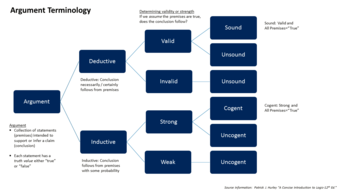
The Anatomy of an Argument
This image outlines the anatomy of an argument. Valid premises lead to sound or cogent conclusions, while invalid premises result in unsound or uncogent conclusions.
Know Your Audience
As you construct your argument, you are
also going to need to understand your audience. As a speaker, you
must be aware not only of what you are trying to say, but also what
your audience already knows about the topic, and their general state
of mind on the subject.
For example, a neuroscientist would
offer a substantially different argument with considerably more
specific details if addressing an audience full of neuroscientists
already aware of the trends in the field. This same speaker
delivering a talk to the general public would need to carefully
consider what information to add or remove in order to bring the
audience up to speed without intimidating them with jargon. It is
primarily in the middle of your speech where this is most important, as it’s very easy to lose your audience in the details.
The 6 I’s of Credibility
With the structure of your discussion
in mind, and a thorough understanding of your audience, you are
almost ready to deliver your core argument. The last topic of
consideration is your own credibility. The following 6 considerations
will help you decide if you are a credible source on the topic, and
how to demonstrate that to your audience:
- Ideation – Find clever ways to
present a concept, and help the audience see how you derived it. - Information – This is where the
premises come in. Make sure your facts are carefully chosen and
communicated. - Influence – Demonstrate confidence
and passion in what you are saying. It’s contagious. -
Integrity – Trust is key. Know what
you don’t know, and make sure the audience does too. -
Impact – Find memorable ways to build
roots in the memories of your audience. Stories and examples are
great tools for this. - Ignition – Finally, make your
conclusion actionable. Motivate your audience not only to agree with
your point, but to build it into their lives.
5.4.4: The End
The ending of a speech can be as important as the beginning and body, because a good end leaves a lasting impression.
Learning Objective
List the different ways of ending a business presentation
Key Points
- After completing the presentation, the presenter should summarize the main points again without repeating verbatim what was said in the introduction.
- “Wow” your audience with one of the techniques for introducing your speech; for example, use a quotation, a startling statistic, a personal experience, a joke, or a formal closure. You may also want to end your speech with a call to action.
- Thanking the audience is one of the most important things to do at the end of a presentation, because they have given up their time to be there.
- Asking for questions is a good way to minimize any confusion that the audience might have or bring to light any relevant connections which you may have overlooked. Answering questions well confirms your authority over the subject matter.
- Thanking the audience is one of the most important things to do at the end of a presentation.
Key Term
- ending
-
A termination or conclusion.
Example
- Remember to thank your audience. Calling for questions can also help the audience clarify any points they may not have understood. For example, “Thank you for your time and attention. Does anyone have any questions? “
Finishing Well
Leaving the audience with a bang ensures making a lasting impression. Remember, the last thing presented tends to be what the audience remembers the best. The ending of a speech is as important as the beginning and body. The conclusion should do what the introduction did, except in reverse.
Ways of Ending a Speech
After completing the presentation, the presenter should summarize the main points again without repeating verbatim what was said in the introduction. You then want to “wow” your audience with one of the techniques you used to introduce your speech. These techniques can include a quotation, a startling statistic, a personal experience, a joke, or a formal closure. If you are presenting persuasive information, you may particularly want to end your speech with a call to action. What are you asking of your audience? What can they do after listening to your speech? Finally, asking for questions is a good way to minimize any confusion that the audience might have or bring to light any relevant connections which you may have overlooked.
Thank Your Audience
While this is one of the most important things to do at the end of a presentation, it is also one of the most frequently forgotten things. Remember that the audience has given up their time to listen to you. They could have been anywhere else in the world doing anything they wanted to do, but they were there with you. You should appreciate that. One way of thanking your audience might be to simply say, “That is all I have for today. I appreciate you giving me your time. Thank you very much and have a great day. “

Training
Training can be conducted in many ways, such as in a lecture or classroom format (above), online, or any number of ways.
Taking Questions
Sometimes it is necessary to take questions at the end of your speech. Many speakers find this challenging, as it is not part of the prepared talk. However, by drawing on your mastery of your subject matter and accurately gauging what the questioner is really asking, you will be able to answer any questions asked in a satisfactory manner. Answering questions effectively strengthens the effect of your speech, as it confirms your authority on the topic in the mind of your audience.
5.4.5: Questions and Answers
The question and answer format is often used to provide a higher quality or higher volume of responses within a business communication.
Learning Objective
Describe the purpose of the question and answer (Q&A) format in business writing
Key Points
- To use this format effectively, the author should anticipate any questions that the reader might have regarding the message and provide the answers.
- The question and answer format (Q & A) presents a series of questions and answers that provides all the pertinent information that the reader needs.
- When presenting a large amount of information that needs to be conveyed, using the question and answer format helps keep the reader engaged.
- The most effective communications answer the following questions. What is the purpose, Who is the audience, Are there any stakeholders, What is the context of this message.
Key Term
- recitation
-
The material recited.
Example
- If you prefer to hold all questions until the end of the presentation, make that clear at the beginning of the presentation. For example, if someone is introducing you as the speaker, that introduction can also include a request to hold questions until the end.
Questions and Answers
Most business writing uses the “one thing after another” approach, which is a plain recitation of the facts . While this method communicates the message, it can often leave the reader with unanswered questions. The question and answer format is often used to provide better or more responses to the business communication.

The Main Purpose of Business Writing
With rhetorical awareness, the focus of communication shifted from simply reproducing forms, templates, and documents to thinking about what the writer wants to accomplish with the document.
In order to use this format effectively, the author should anticipate any questions that the reader might have regarding the message and provide the answers. The question and answer format (Q & A) presents a series of questions and answers that provides all the pertinent information that the reader needs.
While this method is often associated with interviews and other news media, this format doesn’t require two people. The writer essentially asks and answers the question. This format is most successful in the business world when it employs a conversational tone. This method is especially effective in advertising and employee communications.
When presenting a large amount of information that needs to be conveyed, using the question and answer format helps keep the reader engaged. This is because the question and answer format breaks the information down into smaller, easy to read pieces, which can make the content itself seem more inviting. Arranging the questions so they flow into one another encourages the reader to continue and prevents them from skipping over important information.
For example, a memo on upcoming changes to the employee benefit program might include a question and answer like this:
Q: When will the benefits begin?
A: The benefit changes will begin on January 1, 2013
5.4.6: Visuals
Visual aids help us distill complex concepts into clean, elegant expressions that are easily grasped by the audience.
Learning Objective
Integrate visual assets into your presentation skills to clarify your points and simplify your expressions
Key Points
- Visual images have been a part of human communication and language for thousands of years, and for good reason. 60-65% of people think predominantly in pictures, even when listening to words.
- Complexity is a great way to lose the interest of your audience, and visual aids are naturally effective at consolidating complex concepts into elegant high-level expressions.
- There are tons of useful tools to help you on your way, but keep in mind certain visual approaches work better in certain situations than others.
- Graphs are favored for distilling complex data streams into clear correlations, while photos are excellent at building an emotional connection. Consider the point you are making as you select the appropriate image.
Key Terms
- chunking
-
The act of retaining more information through strategically combining concepts.
- visualization
-
The act of transforming data and/or ideas into images.
When delivering an effective presentation, very few tools are more effective than good visuals. There are a number of reasons this is true (aside from the common adage that a picture is worth a thousands words). Understanding why visuals are useful and how to go about using them will give you a critical edge at your next big talk.
Why Visuals Matter
The evolution of communication is largely visual, with pictographs dating back thousands of years. At the onset of communication, humans focused on visual representations of ideas. Approximately 60-65% of people see a series of pictures when listening or looking at a series of words. This is an enormous portion of your audience, so speak their language!
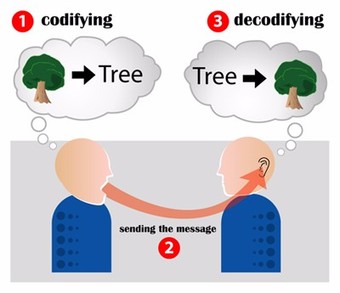
Encoding and Decoding
This image demonstrates the way in which we code and decode messages we send to one another. When I think to say the word tree, and then proceed to say it, you process the word tree and then proceed to think it. Simplifying communication with imagery can often bypass much of the coding and decoding that slows us down.
Aside from this, sometimes the most efficient way to communicate a point with clarity is to wrap up various premises and your core conclusion in one clean image. This can be accomplished through diagrams, charts, tables, graphs, models, and even internet memes. The more creative and memorable the image, the more likely it’ll stick in the forefront of their minds after you’ve gone (which is, after all, the point of all of this).
How To Visualize Well
Specialists in memory and human comprehension confirm that the human mind simply can’t hold all that many words, numbers, or concepts simultaneously. This presents a challenge when communicating complex ideas to a crowd. Distilling complex ideas into an elegant display can aid in this process.
Some of the most useful tools at your disposal are the simplest. Focus on chunking your information, organizing your content, ensuring relevance, creating visual alignment, and emphasizing a single main point. Below is a list of visual aids you can consider, with a brief description of how they are best utilized:
- Physical Objects and Diagrams: These are quite useful when 3-dimensional thinking is required, or when the skill being taught is hands-on. They are not so useful when they are big, distracting, and unwieldy.
- Graphs: For delivering complex data in a single and elegant expression, graphs can’t be beat. However, if there are multiple key concerns and countless possible conclusions, a graph can be quite misleading.
- Photographs: Photos work best when the human element is useful, as they tend to create a sense of empathy and connection. However, photos aren’t as effective at abstraction.
- Maps: Spatial reasoning is difficult, so don’t make people walk through a city via text. Visually showing a map immediately enables your audience to have a strong sense of scope and direction. However, know your audience and keep it simple – maps can also be quite intimidating when over-populated with points of interest.

Gear Pump Diagram
This image shows the breakdown of a gear pump as a technical diagram, with each part clearly labeled and color-coded for ease of understanding. This is an excellent example of how a diagram can help us avoid complex coding and decoding of words, and instead paint a clear image of functionality directly from a visual aid.
5.4.7: Practicing through Anxiety
There are many ideas on how to mitigate the effects of stage fright, such as through thorough preparation and rehearsal.
Learning Objective
List common solutions for dealing with stage fright
Key Points
- In some cases, stage fright may be a part of a larger pattern of social phobia or social anxiety disorder, but many people experience stage fright without any wider problems. Quite often, stage fright arises in a mere anticipation of a performance, often a long time ahead.
- Three solutions to stage fright include: reducing the significance of the other people, eliminating the imagination of negative possibilities, and holding the performance in perspective by seeing its outcome as insignificant in relation to the totality of one’s life.
- Other possible solutions include preparing by rehearsing with visual aids and using physical methods for releasing energy and excitement out of one’s system.
Key Terms
- glossophobia
-
The fear of public speaking.
- stage fright
-
A state of nervousness about performing some action in front of a group of people, on or off a stage; nerves; uncertainty; a lack of self-assurance before an audience.
Example
- One way of reducing anxiety is by rehearsing. If presenting in front of a crowd with a PowerPoint presentation, practice beforehand to coworkers. Rehearse the same way you would deliver the presentation. For example, stand in front of the room or stay seated if recording a webcast.
Stage fright or performance anxiety is the anxiety, fear, or persistent phobia that may be aroused in an individual by the requirement to perform in front of an audience, whether actually or potentially (for example, when performing before a camera). In the context of public speaking, this fear is termed glossophobia, which is one of the most common phobias. Such anxiety may precede or accompany participation in any activity involving public self-presentation. In some cases, stage fright may be a part of a larger pattern of social phobia or social anxiety disorder, but many people experience stage fright without any wider problems.
Solutions to Performance Anxiety
One possible solution to performance anxiety is to reduce the significance of the other people. While experiencing performance anxiety, we often invest the others with imagined power, especially in their ability to affect us through their evaluation of our performance. Ways to reduce this imagined power is to increase the sense of one’s own power, to perceive the vulnerability of others, and to accept oneself.
Another possible solution to performance anxiety is to eliminate the imagination of negative possibilities. A negative outcome is always possible, but that does not justify worrying about it before it occurs. Focusing one’s attention on the present, rather than the future, is much more productive. A way to do this is to monitor our own performance.
A third solution to performance anxiety is to hold the performance in perspective by seeing its outcome as insignificant in relation to the totality of one’s life. By realizing that nothing catastrophic is likely to occur, the need to avoid failure may decrease and switch to a more positive goal. An example of a positive goal would be to provide others with pleasure. Furthermore, it is helpful to focus on the process, the moment-to-moment experience, rather than the results of a performance. Additionally, it is important to concentrate on the enjoyable aspects of the process.
Preparing for Your Speech
There are many ideas on how to mitigate the effects of stage fright. One is as simple as being prepared. According to Lybi Ma with Psychology Today, “Being prepared is your first line of attack. You should be anxious if you haven’t done your homework.”
When preparing to give your speech, it is important to rehearse just as you plan to present it. This includes using your visual aids when you practice. This is necessary to do, since it trains you to make smooth transitions between slides. Take time into consideration as well, since it is hard to sit through a long speech, even if it is interesting. People can usually only concentrate for about twenty minutes at a time. This may mean you need to break your speech up into two parts if it is lengthy. Doing this gives the audience a short break in between and allows them to refocus and retain the important information.
Rehearsing
To rehearse effectively, you should consider the following tips:
- Pay special attention to the delivery of your key points; this is typically where stumbling for your words can become the greatest problem.
- Speak in a conversational style. Do not talk at your audience; pretend you are talking with your audience.
- Prepare for interruptions and questions. On this note, make sure to leave room for questions at the end of your presentation.
- Practice pausing in your speech after important information you would like to stress, as well as when you are transitioning from one main point to another. By doing so, the audience can better digest the information and reflect on what they have just heard.
- Rehearse with your graphics and coordinate them to your talk.
- Display your graphics only when you are talking about them. Graphics should support your presentation, not detract from it.
- Time your rehearsal, and use the same pace you will use when you present.
- Rehearse in front of others. Feedback can improve your speech and having an audience for practice can pinpoint weaknesses in the presentation.
- If possible, rehearse your speech in the location you will be giving it. This will allow you to feel more comfortable when you are giving your presentation.
- Make sure you hear your speech aloud, either by recording it, or by listening carefully to yourself during rehearsal. This will enable you to make sure that your words flow smoothly in an understandable manner.
5.4.8: Dealing with a Difficult Audience
Speaking directly, honestly, and on point can improve the result of a speech, even one in front of a difficult audience.
Learning Objective
Summarize the benefits of delivering extemporaneous speeches
Key Points
- An extemporaneous speech sounds spontaneous because the presenter is not reading word for word.
- The advantage of extemporaneous speeches is that eye contact and body language can increase. The speaker’s head is not down, buried in a manuscript. The speaker is able to take in audience feedback and respond to it as it occurs.
- In dealing with a difficult audience, it is best to be as honest as possible and to remain polite when audience members disagree with points made in the speech.
- It is important to practice presenting with the outline or note cards being used.
- Sometimes your audience may be difficult during the question and answer period. If you do not know the answer to a question asked by an audience member, simply say so, do not lie, and explain any relevant information you do know. If you are interrupted by a question, answer it and continue with your presentation. If an audience member disagrees with your presentation, be polite in your reaction.
Key Term
- extemporaneous
-
Without preparation or advanced thought; offhand.
Example
- Suppose an audience member disagrees with your presentation and presents contrary evidence. Remain polite and respectfully acknowledge the question. If you know the details of the evidence the person has presented, you have the option of presenting a counterargument or reinforcing parts of your presentation that contradict the findings.
Giving a speech or a lecture can be very difficult and intimidating when dealing with a large audience. Not only do presenters have to deal with stage fright, but they have to deal with a difficult audience. If one is unprepared, they can come off as unprofessional. One way to prepare for these situations is by delivering speeches as though they are extemporaneous.
Extemporaneous Speaking
An extemporaneous speech (extemp speech) is delivered from a prepared outline or note cards. The outline or note cards include the main ideas and arguments of the speech. The only information that is typically copied word for word are quotes. Outlines and note cards should be used for keeping the presentation organized and for reminding the presenter what information needs to be provided.
Extemp speaking has many advantages compared to the other methods of delivery. For one, an extemporaneous speech sounds spontaneous because the presenter is not reading word for word. Glancing at an outline or a note card that has key ideas listed allows the presenter to add detail and personality to the information being presented. Second, similar to memorized speaking, eye contact and body language can increase. The speaker’s head is not down, buried in a manuscript. Third, the speaker is able to take in audience feedback and respond to it as it occurs. An audience tends to change moment by moment, and a good speaker can tell when more or less detail is needed for different parts of the presentation.
In order to play to the strengths of extemporaneous speech, it is important to practice presenting with the outline or note cards being used. Inexperienced speakers tend to worry that they will forget important information if they do not write it out on their outline or note card. Practicing your speech, even if it’s just to your pet or mirror, will help increase your confidence level in both delivery and knowledge of the subject. This will help you seem more like an expert in front of your audience.
Answering Difficult Questions
Sometimes your audience may be difficult during the question and answer period . If you do not know the answer to a question asked by an audience member, simply say so, do not lie, and explain any relevant information you do know. If an audience member asks a question in disagreement with your topic, remain in good terms. Politely and respectfully acknowledge the opposing thoughts. If an audience member interrupts your speech with a question, answer it, and return to where you left off.

A Tough Crowd
It may sometimes be difficult to engage the audience during the question and answer period.
5.4.9: Using Humor
Using a joke to start a presentation is often a good idea if used properly.
Learning Objective
Indicate how irony and metaphor are used in presentations
Key Points
- In most cases, keep your joke clean.
- Try to make the joke pertain to the subject you are presenting.
- If you open with humor or use it in any other part of your presentation, be sure to avoid all sexual, religious and racial topics.
Key Terms
- irony
-
A statement that, when taken in context, may actually mean something different from, or the opposite of what is written literally; the use of words expressing something other than their literal intention, notably as a form of humor.
- joke
-
Something said or done for amusement.
- humor
-
The quality of being amusing, comical, funny.
Example
- Here is an example that you might use when doing a presentation on football: “Anyone who makes a bad call against the Detroit Lions risks ticking off their last remaining fan.”
Using Humor
Beginning a presentation with a joke can be an effective strategy for winning over one’s audience, provided the speaker or author knows his or her audience well. However, the speaker better hope the audience thinks the joke is funny! Most often, keeping one’s joke clean is prudent, as not to create discomfort among the audience. Also helpful is telling a joke relevant to the subject being presented. Here, for example, is a joke one might use for a presentation on football: Anyone who makes a bad call against the Detroit Lions risks ticking off their last remaining fan!
Take care with the subject matter as sometimes humor can do more harm than good. If you decide to use humor at any point in your presentation, it is a good rule to avoid all sexual, religious and racial topics or references.
Irony and metaphor
Two common rhetorical devices used to convey special meaning to an audience are irony and metaphor.
The use of irony in rhetoric is primarily to convey an incongruity, often used in humor to deprecate or ridicule an idea or course of action. When taken in context, the statement may actually mean something different from, or opposite of what is said literally.

Irony
A stop sign ironically defaced with a beseechment not to deface stop signs
The use of metaphor in rhetoric is primarily to convey a new idea or meaning by linking it to an existing idea or meaning with which the audience is already familiar. Linking the new with the old and familiar through the use of metaphor is an excellent tool for introducing new concepts to one’s audience.
5.4.10: The Importance of Delivery
Your appearance and delivery are just as important as the content of your speech.
Learning Objective
Explain why appearance and delivery are important in presentations
Key Points
- You want your audience to give you respect and to take you seriously, so be sure to dress well.
- Act poised and confident; don’t let your nerves get the best of you. When rehearsing, identify your weak spots, practice fixing them, as well as practice hitting the crucial points in your speech. Do your best to avoid fidgeting, pacing, looking at the floor, and over using “um”, “uh”, or “and”.
- The most important thing to remember before giving your speech is to deliver your message. If you forget to say certain points it is fine, just deliver your message and let the audience know the main objective of your speech.
- While standing in front of a large or small audience for a presentation, body language is crucial. Remain relaxed and calm, remember to smile, and maintain eye contact with the audience.
Key Terms
- body language
-
Nonverbal communication by means of facial expressions, eye behavior, gestures, posture, and the like; often thought to be involuntary.
- appearance
-
Apparent likeness; external show; how something appears to others.
Example
- Maintain eye contact with the audience. For example, start out your speech looking to the center, and then alternate between left, right, and center for the remainder of the presentation.
The Importance of Delivery
Your appearance and delivery are just as important as your speech. You want your audience to give you respect and to take you seriously, so be sure to dress well. For your dress, consider what your particular audience will expect of you. In most cases, this means business casual, but sometimes a suit or dress may be necessary.
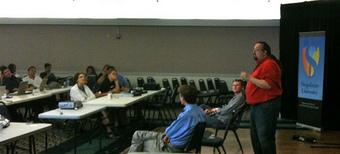
The Importance of Delivery
Your appearance and delivery are just as important as your speech.
In order to dress to impress, men should wear a button-up shirt and tie, blazer (optional), dress pants, and dress shoes. Men should also be clean shaven and have tidy hair.
In order to dress to impress, women should wear a button-up shirt, blouse, or a nice sweater, dress pants or skirt (one that goes below the knee), and dress heels or flats. Women should not wear too much make-up, and they should have tidy hair. Women should also avoid large dangling jewelry, as this can be distracting to your audience.
Deliver Your Message
Act poised and confident; don’t let your nerves get the best of you. Accept your nervousness and work with it. Everyone understands how it feels to be nervous and will be supportive. When rehearsing, identify your weak spots, practice fixing them, as well as practice hitting the crucial points in your speech. Do your best to avoid fidgeting, pacing, looking at the floor, and over using “um”, “uh”, or “and. ” Try to breathe easy and pace your speech. The most important thing to remember before giving your speech is to deliver your message. If you forget to say certain points it is fine, just deliver your message and let the audience know the main objective of your speech. Find comfort in knowing that your nervousness is not as visible to others as it is to you.
Body Language
While standing in front of a large or small audience for a presentation, body language is crucial. Audiences may become distracted if you flail a laser pointer or fidget with a pen. As a presenter, remain relaxed and calm while creating animated and lively facial expressions. Always remember to smile, maintain eye contact with the audience, and enjoy your experience as a presenter.
Your Audience
The great thing about presenting a speech is that you can gauge the understanding of your audience by paying attention to them. If your listeners are looking confused, you can ask if they understand before moving on to the next point. You can then back-up and re-explain your points as needed. Make eye contact with your audience members, and make sure not to stare at your notes the whole time. If you have a large audience, make sure to alternate talking to the audience members to the right and left of you as well as in front of you. When you begin your speech do not look at your notes, look at your audience! You know your topic and who you are so introduce yourself and your topic as you would introduce yourself when you meet a new person.
The following strategies will help you look at your audience:
- Look at your audience before you begin
- Create and follow a plan for looking
- Pick a particular feature of your listeners’ faces
- Practice looking at the audience while rehearsing
- Avoid skimming over faces in your audience
5.5: Word Choice
5.5.1: Keeping the Audience in Mind
The most important concept to keep in mind when writing for business is who your target audience is.
Learning Objective
List the best practices for writing for business audiences
Key Points
- You need to tailor your writing to fit different audiences in different situations. If you address the document’s specific target audience in terms they understand, your document will have a better chance of achieving its goal.
- When selecting words, your first goal should be to increase the usability of your writing by enabling your readers to grasp your meaning quickly and accurately. At the same time, keep in mind that your word choices affect the attitudes your readers have toward you and your subject matter.
- Generally, keeping it simple is a good policy. By not over-elaborating and not using unnecessarily complex words, you make the message easy to understand and accessible to all. There may be situations in which more complex writing is needed, however.
Key Term
- target audience
-
The primary group of people that something, usually an advertising campaign, is aimed at appealing to.
Example
- When writing a business proposal to upper management, your tone would likely be more professional and your word choice more formal than if you were writing an email proposing a team bonding activity.
The most important concept to keep in mind when writing for business is who your target audience is. You need to tailor your writing to fit different audiences in different situations. If you address the document’s specific target audience in terms they understand, your document will have a better chance of achieving its goal.
Every business document has a purpose. You could be trying to persuade your boss that you are due a raise in one instance, and trying to persuade the HR Department that the company picnic would have more participation if it were held at a lake in another instance. In both instances, the language and way you would approach each topic is going to differ .

Know Your Audience
It is important to know your target audience for any piece that you write.
When selecting your words, your first goal should be to increase the usability of your writing by enabling your readers to grasp your meaning quickly and accurately. At the same time, keep in mind that your word choices affect the attitudes your readers have toward you and your subject matter. You also need to choose words that will increase your communication’s persuasiveness. Word choice could make a difference in how your voice is heard and your writing is perceived. A formal tone and more official word selection leads to a very different type of piece than an informal tone and simpler word selection. It is almost always advisable to let a trusted colleague read your writing, and offer suggestions, if needed, before you finalize it to make sure that it accurately and effectively conveys the message that you want it to for your intended audience.
In general, you are keeping the audience in mind when you:
- Use concrete, specific words.
- Use specialized terms only when your readers will understand them.
- Use words accurately.
- Choose plain words over fancy ones.
- Choose words with appropriate associations and connotations.
- Consider the cultural background of your readers when choosing words.
- Use inclusive language.
5.5.2: Avoiding Slang and Jargon
When writing business documents, only use jargon when necessary with appropriate audiences, and completely avoid the use of slang words.
Learning Objective
Differentiate between jargon and slang
Key Points
- Jargon refers to the common vocabulary used by specific professions or groups of people, whereas slang includes expressions and types of speech used informally.
- You can increase the usability and persuasiveness of your writing by wisely using the specialized terms of your own profession.
- Jargon should be avoided when it is only used for the sake of looking knowledgeable in a particular subject as it can make it difficult to understand what is being said. Generally, slang should always be avoided.
Key Terms
- slang
-
Language outside of conventional usage.
- jargon
-
A technical terminology unique to a particular subject.
Example
- Business jargon includes terms like bandwidth, deliverable, bad apples, low-hanging fruit, and Six Sigma. If writing to an audience familiar with the terminology, using these terms can be more efficient. If writing to an audience that is unfamiliar with the terminology, it is best to use broader terms.
Jargon Defined
Jargon is the common vocabulary used by specific professions or groups of people within those professions. It can be similar to slang or it can be highly technical. Legal jargon, medical jargon, and police jargon are all examples of different types of jargon that exist in very different professions .
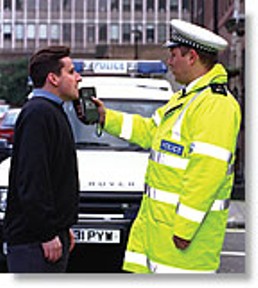
Police Jargon
Police have their own specific jargon which may not be understood by those outside the profession.
Much like slang, jargon can develop as a kind of short-hand to express ideas that are frequently discussed between members of a group, though it can also be developed deliberately using chosen terms. A standard term may be given a more precise or unique usage among practitioners of a field. In many cases, this causes a barrier to communication with those not familiar with the language of the field. As an example, the words RAM, bit, byte, CPU, HDD, and hexadecimal are jargon terms related to computing.
When writing business documents, it is recommended that authors avoid using technical jargon for the sake of looking smart. Instead, they should use it only when necessary with appropriate audiences who understand their significance. Using simple verbiage instead ensures understanding by a broad spectrum of users.
When to Use Jargon
You can increase the usability and persuasiveness of your writing by wisely using the specialized terms of your own profession. You should use jargon to convey precise, technical meanings efficiently, as many terms have no exact equivalent in everyday speech.
In addition, you should use jargon to help you establish credibility. By using the specialized terms of your field accurately, you show your fellow specialists that you are adept in it. However, you should avoid using technical terms your readers will not understand.
Slang
The term slang includes words, expressions, or the special use of language, used in informal speech.
Slang is especially common in pop, rock, jazz, and rap music, as well as in films, all of which tend to have international audiences. As a result, many foreign speakers who have learned more formal registers are sometimes surprised when they hear expressions like: “I gotta go! ” (I have to go now), or “What’s up bro? ” (How are you my friend). In certain regions, certain dialects may have this non-standard language incorporated into “normal” speech.
Writers of official documents or papers should avoid using slang, whatever the context. While jargon may be acceptable in certain types of documents, one should avoid using slang words, even in documents like memos that always have a conversational style.
5.5.3: Using Impartial Language
In business writing, it is important to communicate the message using impartial or unbiased language.
Learning Objective
Explain why it is important to use impartial language in business writing
Key Points
- Not only does biased language have the potential to offend readers, but it also negatively affects the writer’s credibility and distracts from the message being conveyed.
- Choosing unbiased language avoids offensive language and ensures that the message is effectively communicated.
- Writers should write in a way that is free from gender and group stereotypes including race, age, ethnicity, disability, or sexual orientation.
- When writing business correspondence use respectful language.
Key Term
- unbiased
-
Impartial or without bias or prejudice.
Example
- Always use the preferred designations for ethnic and racial groups. Descriptors used to identify a group should be precise. For instance: In clinical studies, the drug was less effective in Asian, Hispanic, and African American women.
Impartial Language
In business writing, it is important to communicate the message using impartial or unbiased language. Choosing unbiased language avoids offensive language and ensures that the message is effectively communicated. Not only does biased language have the potential to offend readers, but it also negatively affects the writer’s credibility and distracts from the message being conveyed .
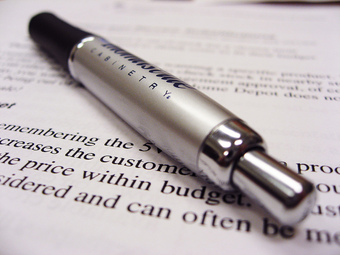
Impartial Language
In business writing, it is important to communicate the message using impartial or unbiased language.
Using Unbiased Language
Writers should write in a way that is free from gender and group stereotypes including race, age, ethnicity, disability, or sexual orientation. Here are a few examples that illustrate the use of unbiased language:
Disability
Language that labels individuals by their disability and use of emotionally impartial expressions should be avoided.
Before editing: The facility should be reconstructed because it is not accessible for individuals confined to wheelchairs.
After editing: The facility should be reconstructed because it is not accessible for individuals who use wheelchairs.
Gender
Gender language that could be considered sexist or stereotypical should be avoided. Gender should only be specified if necessary for clarity.
Before editing: The instructor should consider the needs of his students when developing the syllabus.
After editing: Instructors should consider the needs of their students when developing the syllabus.
Racial or Ethnic Identity
Always use the preferred designations for ethnic and racial groups. Descriptors used to identify a group should be precise.
Before editing: In clinical studies, the drug was less effective in Oriental and other Non-White women.
After editing: In clinical studies, the drug was less effective in Asian, Hispanic, and African American women.
5.5.4: Avoiding Passive Voice
A way to focus your sentences on action and actors is to use the active voice rather than the passive voice.
Learning Objective
Give examples of situations where it is appropriate to use passive voice in business writing
Key Points
- To write the active voice, place the actor, which is the person or the thing performing the action, in the subject position. Your verb will then describe the actor’s action.
- Research shows that readers comprehend active sentences more rapidly than passive ones. The active voice also eliminates the vagueness and ambiguity that often characterizes the passive voice.
- Although the passive voice generally reduces readability, it has some good uses, such as when you don’t want to identify the actor.
Key Terms
- active
-
Having the power or quality of acting; causing change; communicating action or motion; acting.
- passive
-
Being subjected to an action without producing a reaction.
Example
- Example of the active voice: The chicken crossed the road.
The Passive Voice Defined
In writing, the passive voice is when the grammatical subject of the verb is the recipient (not the source) of the action denoted by the verb. For example, “the changes were recommended by the consultant” is an example of the passive voice.
Reasons to Avoid the Passive Voice
Research shows that readers comprehend active sentences more rapidly than passive ones. The active voice also eliminates the vagueness and ambiguity that often characterize the passive voice. In the passive voice, a sentence can describe an action without telling who did it. For example, “The ball was hit” is a grammatically correct sentence, but doesn’t tell who or what hit the ball. With the active voice, the writer identifies the actor: “Linda hit the ball. ” Keep in mind, the passive voice is not a grammatical error, it is a stylistic choice.
The active voice keeps the focus of the sentence on the action. To write the active voice, place the actor, which is the person or the thing performing the action, in the subject position. The verb will then describe the actor’s action.
In business writing, the use of the active voice is important to get people to answer a call to action. A memo written in the active voice will have a greater impact than one written in the passive voice. Using the active instead of passive voice in writing technical documents and instructions helps readers understand everything immediately without having to read anything twice.
Appropriate Uses of the Passive Voice
Although the passive voice generally reduces readability, it has some good uses, such as when you don’t want to identify the actor. If the writer decides it would be ethically acceptable to communicate news to the reader without naming the person who made the report, the passive voice is okay. Be careful to avoid using the passive voice to hide an actor’s identity when it is unethical to do so, such as when trying to avoid accepting responsibility for your employer’s actions.

Passive Voice
Using the passive voice in your writing can obscure the meaning of your message.
5.6: Audience Analysis
5.6.1: Anticipating Audience Reaction
It is important to tailor the message to the audience, so the writer must identify the interests, needs, and personality of the audience.
Learning Objective
Discuss the factors business writers must consider when anticipating audience reaction
Key Points
- For business writing, this includes taking into account whether the message is intended for a higher up or a subordinate, and a singular person or a group of people.
- Once the writer determines who the audience is, it is time to consider what reaction the message will generate. If the writer anticipates a positive response, the language of the message can direct.
- When anticipating a negative reaction, the writer must use a great deal of persuasion. This can include using expert opinion and external evidence for support.
- It is essential to pay attention to the tone of the message, because it is a good indicator of how the reader will feel while reading the message.
Key Terms
- tone
-
The manner in which speech or writing is expressed.
- reaction
-
An action or statement in response to a stimulus or other event.
Example
- If the writer/presenter anticipates a positive reaction, she can be direct, stating outright that, for example, a certain change should be made. If the expected reaction is negative, the writer/presenter may start by listing problems caused by the current situation to encourage the audience to consider the problems objectively prior to suggesting changes.
Anticipating Audience Reaction
When writing a message, it is important to tailor the message to the audience. In order to do so, the writer must identify the interests, needs, and personality of the audience . For business writing, this includes taking into account whether the message is intended for a higher up or a subordinate, and a singular person or a group of people.
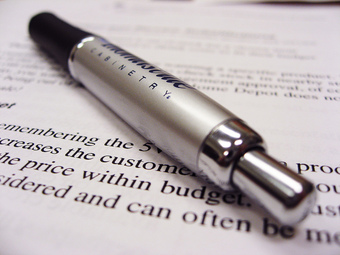
Impartial Language
In business writing, it is important to communicate the message using impartial or unbiased language.
Once the writer determines who the audience, it is time to consider what reaction the message will generate. If the writer anticipates a positive response, the language of the message can direct. On the other hand, if the writer anticipates a neutral reaction to the message, it is necessary to use language that is more persuasive. Writing a message when the anticipated reaction is a negative one requires the most effort. In this case, the writer must use a great deal of persuasion. This can include using expert opinion and external evidence for support.
The Role of Tone in Audience Reaction
It is essential to pay attention to the tone of the message, because it is a good indicator of how the reader will feel while reading the message. A professional, yet friendly tone makes the writer sound both professional and approachable. Keep in mind that the best messages rely on words that will have a positive impact on the tone of the message. One way to do this is to put the focus of the message on the receiver. This can be achieved by using second-person pronouns throughout the text. This shows that the writer has empathy toward the reader.
Another technique involves using bias-free language, which means the message should be free from gender, race, age, and disability bias. Improperly chosen words can contribute to an overall negative tone and make an otherwise innocuous message sound unpleasant. It is a good idea to use positive words and avoid words that have negative connotations. The most effective messages use simple language and words that are precise, which prevents any miscommunication.
5.6.2: Dynamically Crafting your Message
The most important aspect of business writing is clear and concise writing that gets the message across in the best way.
Learning Objective
Describe how to craft a clear and concise business message
Key Points
- The opening sentence or section or business writing takes on a special importance. It helps to establish the frame of mind readers bring to all the sentences and sections that follow. It also grabs the attention of viewers and keeps them focused until the end.
- The most important function of the beginning is to persuade your readers to devote their full attention to your message rather than skimming it or setting it aside unfinished.
- Unless your communication is very short, its beginning should tell readers what to expect in the segments that follow. A forecasting statement positioned at the beginning of a communication should focus its organization and scope.
- Readers’ expectations and preferences about the beginning of a communication are shaped by their culture.
Key Terms
- unethical
-
Not morally approvable; morally bad; not ethical.
- scope
-
The breadth, depth, or reach of a subject; a domain.
Example
- An e-mail may have a subject line “Next Steps from Organizational Meeting: Assignments” with an outline listing each step and who it is assigned to. The body of the email would further detail each step. The subject line is designed to clearly indicate that it needs to be opened and read by those to whom it pertains. The outline provides a summary for those who may need to be aware of the contents but not need details. Further information is provided later in the email for those to whom it is relevant.
Crafting the Message
Writing is a dynamic interaction between readers and authors. The response of readers to one sentence or paragraph can influence their reactions to all the sentences and paragraphs that follow. Consequently, the opening sentence or section takes on a special importance. It helps to establish the frame of mind readers bring to all the sentences and sections that follow. It also grabs the attention of viewers and keeps them focused until the end.
Give Your Readers a Reason to Pay Attention
The most important function of the beginning of the message to persuade readers to devote their full attention to your message . At work, people complain that they receive too many e-mails and reports. Your goal is to convince them to pay close attention to the message.

Know Your Audience
Give your readers a reason to pay attention.
Tell Your Readers What to Expect
Unless your communication is short, its beginning should tell readers what to expect in the segments that follow. A forecasting statement positioned at the beginning of a communication should focus its organization and scope. This will serve a couple of purposes. First, it will narrow the reader’s attention to only what needs to be addressed. Second, it will deter some of the readers to whom you are not intending to write. This could help in avoiding lawsuits.
Tell about Your Communication’s Organization
By telling your readers about your communication’s organization in your beginning, you provide them with a framework for understanding the connections among the various pieces of information you convey. This framework substantially increases your communication’s usability by helping your readers immediately see how each new point you make relates to a point that they have already read. It also helps skimming readers navigate quickly to the information that they are seeking.
Tell about Your Communication’s Scope
Readers want to know from the beginning what a communication does and does not contain. Even if they are persuaded that you are addressing a subject relevant to them, they may still wonder whether you discuss the specific aspects of the subject that they want to know about. Often you will tell your readers about the scope of your communication when you tell about its organization: when you list the topics it addresses, you indicate its scope. There will be times however, when you will need to include additional information. That happens when you are not addressing your subject comprehensively or are addressing it from a particular point of view.
Encourage Openness to Your Message
Because the way you begin a communication has a strong effect on your readers’ response, you should always pay attention to the persuasive dimension of your beginnings. Always begin in a way that encourages your readers to be open and receptive to the rest of your communication.
Provide Necessary Background Information
As you draft the beginning of a communication, ask yourself whether your readers will need any background information to understand what you are going to tell them.
Include a Summary Unless Your Communication is Very Short
Summaries help busy managers learn the main points without reading the entire document, and they give those readers an overview of the communication’s content and organization. For longer communications, especially those that are long enough to have covers and tables of contents, these summaries are longer and often printed on a separate page.
Adjust the Length of Your Beginning to Your Readers’ Needs
There is no rule of thumb that tells how long the beginning should be. A good, reader-centered beginning may require only a phrase or may take several pages. You need to give your readers only the information that they don’t already know.
Adapt Your Beginning to Your Readers’ Cultural Background
Readers’ expectations and preferences about the beginning of a communication are shaped by their culture. The suggestions you have just read are suitable for readers in the United States and some other Western countries. However, customs vary widely. You must have good understanding of the communication customs of your readers’ culture in order to create an effective opening. If you do not have this understanding, do some research or seek out someone who is from that culture to ask him.
Ethics Guideline: Begin to Address Unethical Practices Promptly and Strategically
Suppose you learn that your employer is engaged in an action you consider to be unethical. Or you are asked to write something that violates your sense of what is ethical. Should you speak up or express your concerns in writing? New employees are sometimes advised to wait until they have achieved security and status before trying to bring about change. But that means you could spend years before addressing a practice you regard as unethical. Ignoring an unethical act would be seen as unethical in itself.
